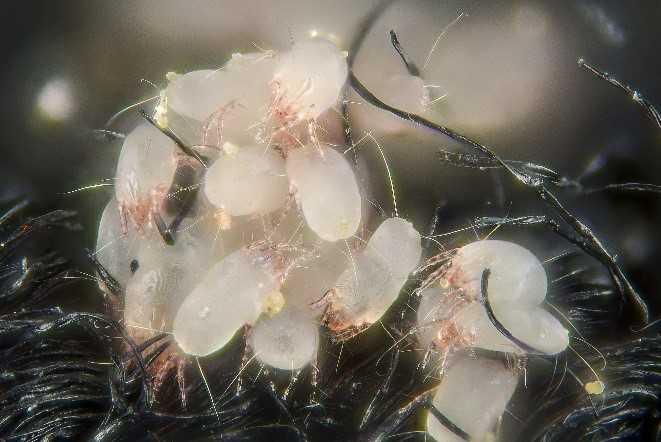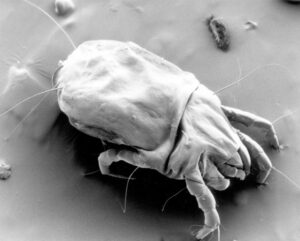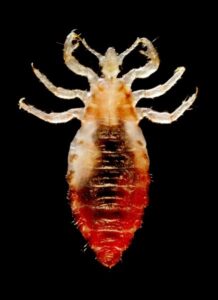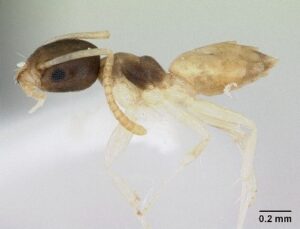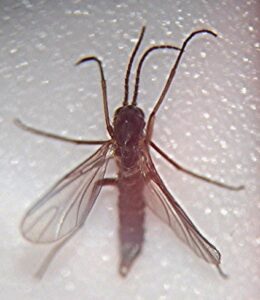Introduction
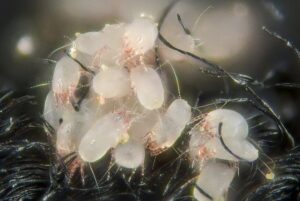
The group of mites, belonging to the order Acarina, contains a very large number of species, reaching 50,000 species. Most species are barely visible to the naked eye (0.5 to 2.0 mm long). They have eight legs and a body with practically no division (similar to ticks). They live freely, except for a few that parasitize living organisms. Some of them are also considered non-intrusive health pests as a result of the painful and irritating biting and stinging they cause, and they may cause allergic diseases for some people with high sensitivity to the chitin proteins that form the insects’ cuticles.
Parasitic mites cause common skin diseases known as scabies, and some species also transmit serious diseases to humans such as pruritic typhus. There are other species that feed on skin secretions and scales and cause severe skin infections. And the many species that parasitize animals and birds may be transmitted accidentally to humans and cause temporary skin irritations, just as it has been proven that chicken mites may transmit cerebral fever to humans.
The most common mites encountered in UAE are:
- House Dust Mites:
- European House Dust Mite – Dermatophgoides pteronyssinus (Trouesart) (Family Pyroglyphidae: Order Acarina)
- America House Dust Mite – Dermatophgoides farina Hughes (Family Pyroglyphidae: Order Acarina)
- Harvest mites or Chiggers – Trombicula spp. (Family Trombiculidae:
Order Trombidiformes) - Scabies, Itch Mites, or Short-Legged Mites – Sarcoptes scabiei (Linnaeus) (Family Sarcoptidae: Order Sarcoptiformes)
Click on each mite species to learn about its general description, life cycle, common characteristics, damage, and medical implication.
House Dust Mite:
General Description
|
A scanning electron micrograph of a female – CSIRO |
Life Cycle and Common Characteristics
|

Dermatophagoides pteronyssinus Credit: Gilles San Martin |
- The average life of a house dust mite is 65-100 days, and as soon as it reaches puberty, the female lays eggs at a rate of 1-2 eggs/day.
- A mated female can live up to 70 days, laying 60 to 100 eggs in the last five weeks of her life.
- Mattresses and carpets are among the most suitable places for the living and breeding of the mite, as the food of the mite gathers in them.
- They live indoors and feed on dandruff and food particles. When hiding places are available, they breed in places where temperatures range between 20-30°C and the average relative humidity is 75%. Indoor heat and humidity are extremely important for the spread of mites.
- This mite can produce approximately 2,000 fecal particles in a 10-week lifespan.
Damage and Medical Implications
- The house dust mite is a small living organism that does not bite a person or suck his blood. It has an ominous appearance when magnified under an electron microscope, but it appears white when viewed by different means.
- The mite leaves fine particles of feces in the dust of the houses, and these may also cause allergies.
- Dead mites in the dust retain their ability to cause allergies.
- The household dust mite is one of the biggest problems, as its entry into the inhaled air in the breathing process causes allergic diseases of the respiratory system. Different types of allergic diseases may occur, but asthma is considered one of the most important of them all because it is the most common and the largest number of patients suffer from it. In addition to inflammation of the body in many areas.
2-Harvest Mites or Chiggers:
General Description
|
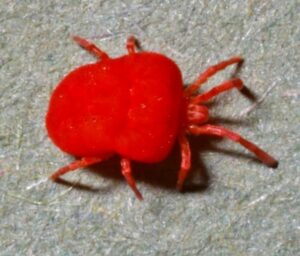 |
Life Cycle and Common Characteristics
- After one week of the egg laying, the egg shell splits, exposing the mature larva.
- Chiggers are the larval-staged organism in the life cycle of the harvest mites.
- It prefers to live in dry areas at a depth of 5-8 cm, so it can be found in home barns in feeding and resting places, where it feeds on decomposing organic matter.
- In most temperate zone, chiggers have one annual generation.
Damage and Medical Implications
- Followed by the genus Trombicula, in which the adult animals and nymphs are non-intrusive, and live in the land free living.
- The larval stage is the stage that parasitizes humans, dogs, and other animals and birds.
- The mite transmits Tsutsugamushi (mite disease) to humans, and the cause is a type of rickettsia.

- Females lay eggs on the soil, and the larva comes out after 6 days and climbs the grass or walls, then sticks to the passing animal or human, and the larva pierces the skin and injects the secretions of the salivary glands that work to analyze the skin tissues, then it feeds on the digested tissues (i.e. it does not feed on the blood of the host). The person does not feel the stages of puncturing the skin and decomposing the tissues, but welts or blister-like appearance appear later on the body (each welt measured approximately 3-4 mm in diameter) and a strong tendency to scratch, so the inflammation increases and ulcers are formed that may be contaminated with bacteria.

- The rickettsia microbe is transmitted from the larvae to the next stages, then to the eggs, and when the larvae emerge, they are infectious with the pathogen.
- Scabies, Itch Mites or Short-Legged Mites:
General Description
|
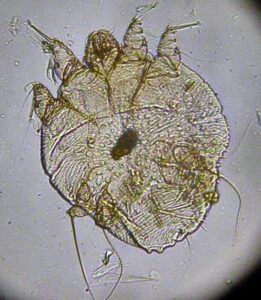
Credit: Kalumet |
Life Cycle and Common Characteristics
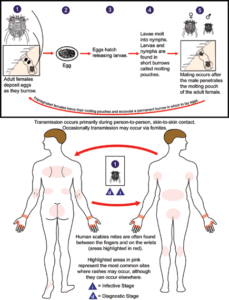
- The most important subfamily is the short-legged mite Sarcoptes scabiei, also called the itch mite.
- This species infests humans, horses, sheep, rabbits, cats, and birds, as well as cattle and camels.
- The female carrying eggs (their length ranges from a few millimeters to about 2.5 cm) digs skin-branching tunnels in thin areas of the skin, especially between the fingers, on the arms, on the hips, and on the genitals. The depth of the tunnel is from several millimeters to several centimeters.
- Only the adult female penetrates the host and paves the way for the remaining instars to enter. The female can bury herself in the skin within 3 minutes. She lays eggs at the end of the tunnel at a rate of 3 eggs per day for two months. Then, the female dies after that. The eggs hatch into larvae after 3-5 days, which may remain inside the tunnel or dig new ones. The larva molts twice within 6-8 days and turns into a full-fledged animal.
- Males (smaller than females) dig their own tunnels and then leave them to roam the surface of the skin in search of females.
- The life cycle takes 10-14 days.
Damage and Medical Implications
- Species of the family Sarcoptidae and Demodiidae cause scabies in humans. Manifestations and symptoms of scabies vary according to the type of mites causing it.
|
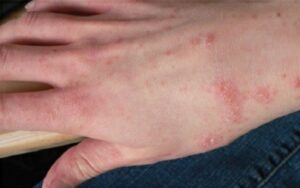
Credit: CDC |
- The general symptoms of scabies are the occurrence of infections and skin tumors accompanied by a severe itching tendency, which causes the infection to widen, the skin cracks, the serum comes out of it, and the hair falls out. If the affected place is rubbed with anything, it will rupture and ugly exfoliation will form. Some abscesses may form if the wounds are contaminated with bacteria.
- Transmission occurs primarily by the transfer of the impregnated females during person-to-person, skin-to-skin contact. Occasionally transmission may occur via bedding or clothing.
Scabies, Itch Mites or Short-Legged Mites:
General Description
|

Credit: Kalumet |
Life Cycle and Common Characteristics

- The most important subfamily is the short-legged mite Sarcoptes scabiei, also called the itch mite.
- This species infests humans, horses, sheep, rabbits, cats, and birds, as well as cattle and camels.
- The female carrying eggs (their length ranges from a few millimeters to about 2.5 cm) digs skin-branching tunnels in thin areas of the skin, especially between the fingers, on the arms, on the hips, and on the genitals. The depth of the tunnel is from several millimeters to several centimeters.
- Only the adult female penetrates the host and paves the way for the remaining instars to enter. The female can bury herself in the skin within 3 minutes. She lays eggs at the end of the tunnel at a rate of 3 eggs per day for two months. Then, the female dies after that. The eggs hatch into larvae after 3-5 days, which may remain inside the tunnel or dig new ones. The larva molts twice within 6-8 days and turns into a full-fledged animal.
- Males (smaller than females) dig their own tunnels and then leave them to roam the surface of the skin in search of females.
- The life cycle takes 10-14 days.
Damage and Medical Implications
- Species of the family Sarcoptidae and Demodiidae cause scabies in humans. Manifestations and symptoms of scabies vary according to the type of mites causing it.
|

Credit: CDC |
- The general symptoms of scabies are the occurrence of infections and skin tumors accompanied by a severe itching tendency, which causes the infection to widen, the skin cracks, the serum comes out of it, and the hair falls out. If the affected place is rubbed with anything, it will rupture and ugly exfoliation will form. Some abscesses may form if the wounds are contaminated with bacteria.
- Transmission occurs primarily by the transfer of the impregnated females during person-to-person, skin-to-skin contact. Occasionally transmission may occur via bedding or clothing.

